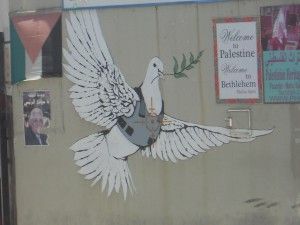 Prior to my trip to Israel, I’ll admit I had stereotypes. I feared for my safety at first, but those fears quickly disappeared as I began to learn about the culture and encountered the friendliness of the locals.
Prior to my trip to Israel, I’ll admit I had stereotypes. I feared for my safety at first, but those fears quickly disappeared as I began to learn about the culture and encountered the friendliness of the locals.
Then, before our group drove into Bethlehem, I had more stereotypes. As a Christian, I imagined the “little town of Bethlehem” as a quaint place of Jesus’ birth. Instead, I found a huge church built over Jesus’ birthplace, tourist shops lining the street, complete with a “Stars & Bucks” coffee shop, and—most prominently—the massive West Bank wall that separates the borders of Bethlehem and Jerusalem.
In other words, the wall puts a physical barrier between the Palestinians and the Israelis. In my opinion, all it does is create a damper mood for anyone visiting the famous city.
When I said “massive,” I wasn’t kidding. It’s constructed out of concrete with barbed wire and guard towers. Plus, there are two lines of security booths you must pass through to enter. I had heard about it before—some compare it to the Berlin Wall—but to see it in person was definitely an experience to remember.
The wall is in place for safety reasons. Primarily, to stop Palestinian terrorists from attacking Israeli citizens, according to BBC News.
However, building a large tightly guarded barrier between two bickering groups of people doesn’t appear to place Israel and Palestine on the path to successful relational peace building. In addition, it seems quite ironic to have any sort of barrier separating the place of Jesus’ birth from the rest of Israel.
Nevertheless, glimpses of hope provided me with an extremely dim light at the end of the tunnel, so to speak.
After visiting the Church of Nativity, we went to the Herodian Store, which is basically a large tourist shop owned by a well-known Palestinian Christian man. Then, in the short distance from the storefront to the bus, a young boy selling wooden flutes came up to me.
Now, in most cases, I would have followed the 20 other people on our bus and politely waved the boy off, but this time my gut told me to do otherwise.
I attempted to decline the boy’s first few offers as I slowly walked to the bus, yet, as all good salesmen are, he was persistent. I eventually gave in, paying 30 shekels for four flutes.
As I lightly haggled with him, various thoughts went through my head, especially after he pleaded that he had a “big family” to care for. Whether or not that was true or simply a sales tactic didn’t matter to me, though it was most likely the latter.
In that split second—this may be overdramatized because I am an American but you get the point—I realized that this kid did not have the freedom he deserves. There was no way I was going to deny him this sale of 30 shekels, which is equivalent to a mere $7.60.
The fact that this Palestinian boy had enough in himself to be out on the street selling wooden flutes, in a strange way, gave me hope for the future of Israel that was further intensified by a dialogue our Pepperdine group was fortunate enough to be engaged in over dinner later that day.
We met up with a Palestinian Arab Muslim woman who lived in Israel. Before, I explained that the government has set a wall to separate the Palestinians and Israelis, so one can only imagine the struggles she faces as a Palestinian raising a family alongside Israelis—a seemingly hopeless situation.
This woman was the furthest thing from a hopeless situation. She approached each question with optimism, and assured us that she faced obstacles but that none of them were impossible to overcome.
Furthermore, when she spoke about the details of her Muslim religion, she gave me a spark of hope for the possibility of religious tolerance in the far future.
The questions of whether or not Muslims are allowed to marry people of other religions came up. She responded saying that typically the only time that would happen is between a Jewish woman and a Muslim man.
But then she countered her explanation by saying, despite what the Quran says, she hopes one-day, “anyone [will be able to] marry anyone.” That jumped out at me.
Basically, this woman was putting aside her own religion’s hardcore traditional beliefs in the interest of creating dialogue amongst the currently mostly segregated religions within Israel.
A thick concrete wall may separate the Palestinians and Israelis, but if there are more children like this boy who learned English enough to interact with some American tourists, and more people like this woman who is willing to put aside a single belief for the possibility of inter-religious dialogue, then maybe there is hope.

